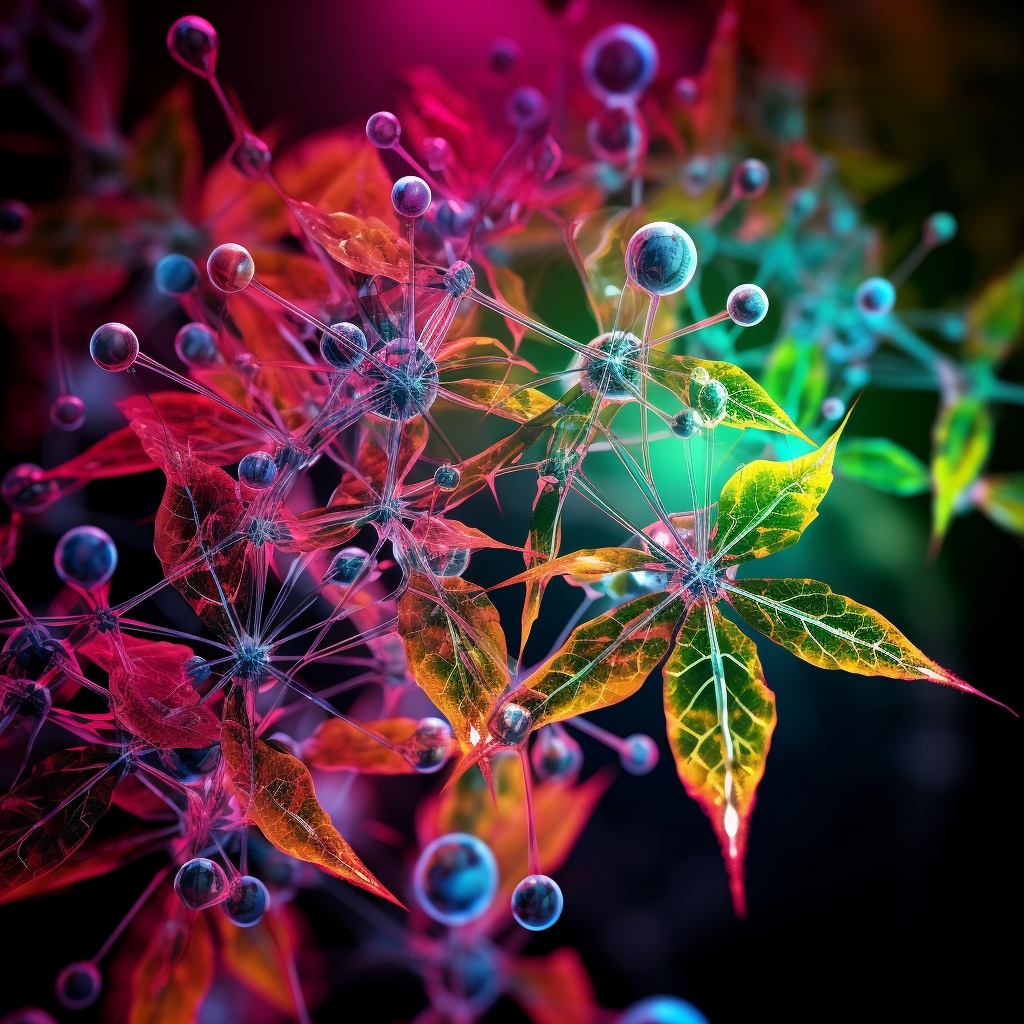Cannabis, a plant that has been used for its medicinal and recreational properties for centuries, is gaining significant attention in the modern world. With the legalization and decriminalization of cannabis in many regions, there has been a surge of interest in understanding its various components, particularly cannabinoids.
Cannabinoids are chemical compounds found in the cannabis plant, and they interact with the body’s endocannabinoid system to produce various effects. While there are over 100 different cannabinoids identified in cannabis, each with its own unique properties, some are more well-known and widely studied than others.
One of the most commonly recognized cannabinoids is tetrahydrocannabinol (THC), which is responsible for the euphoric “high” associated with cannabis use. THC has been found to have analgesic, anti-inflammatory, and appetite-stimulating effects, making it useful for medical applications.
Another prominent cannabinoid is cannabidiol (CBD), which has gained significant popularity in recent years due to its potential therapeutic benefits without the psychoactive effects. CBD has been studied for its potential to relieve pain, reduce anxiety and depression, alleviate symptoms of epilepsy, and even help with certain skin conditions. Its non-intoxicating nature makes it appealing to those seeking the potential health benefits of cannabis without the “high.”
Beyond THC and CBD, there are several other cannabinoids worth exploring. Cannabigerol (CBG) is a non-intoxicating cannabinoid that may have potential as an anti-inflammatory, analgesic, and neuroprotective agent. Cannabinol (CBN) is often associated with sedative effects and may have potential as a sleep aid. Other cannabinoids, such as cannabichromene (CBC) and tetrahydrocannabivarin (THCV), are also being studied for their potential therapeutic properties.
Understanding the various cannabinoids found in cannabis is crucial for both recreational users and those considering using cannabis for its medicinal benefits. With further research and scientific advancements, we are uncovering the potential applications and benefits of these cannabinoids, providing individuals with a wider range of options when it comes to cannabis consumption.
In this comprehensive guide, we will delve deeper into the world of cannabis cannabinoids, exploring their individual properties, potential therapeutic benefits, and the science behind their interactions with the human body. By gaining a better understanding of these compounds, we can make informed decisions about how to utilize cannabis for both recreational and medicinal purposes. So, let’s embark on this journey into the fascinating world of cannabis cannabinoids, and discover the potential they hold.
What are Cannabinoids?
Cannabinoids are naturally occurring chemical compounds found in the Cannabis plant. These compounds are known for interacting with the body’s endocannabinoid system, which plays a crucial role in maintaining homeostasis and regulating various physiological processes. With over 100 identified cannabinoids, each with its own unique properties and effects, it can be overwhelming to understand what exactly they are and how they differ from one another.
One of the most well-known cannabinoids is delta-9-tetrahydrocannabinol (THC), which is responsible for the psychoactive effects commonly associated with cannabis use. THC binds to the cannabinoid receptors in the brain, resulting in euphoria, relaxation, and altered perception. It is important to note that THC levels vary in different cannabis strains, and some products are bred to have higher THC content for recreational or medicinal purposes.
Another prominent cannabinoid is cannabidiol (CBD), which has gained significant attention in recent years for its potential therapeutic benefits. Unlike THC, CBD does not produce intoxicating effects. Instead, it is believed to modulate various physiological functions, including pain perception, inflammation, anxiety, and sleep. CBD has garnered interest from both medical professionals and consumers looking for natural alternatives for their well-being.
Other cannabinoids that have been extensively studied include cannabinol (CBN), cannabigerol (CBG), and cannabichromene (CBC). CBN is thought to have sedative properties, making it potentially useful for promoting sleep. CBG is known for its potential anti-inflammatory and anti-anxiety effects, while CBC is being researched for its potential as an anti-inflammatory and analgesic agent.
It is essential to understand that cannabinoids work synergistically, and their effects can vary depending on the specific combination and concentration. This phenomenon, known as the entourage effect, suggests that the presence of multiple cannabinoids and other plant compounds may enhance the overall therapeutic potential of cannabis products.
To ensure responsible and informed use, it’s crucial to be aware of the specific cannabinoids present in the cannabis products you consume. Understanding the differences and potential effects of cannabinoids can help you make informed decisions about which products may best suit your needs and desired outcomes.
Before incorporating any cannabis-derived product into your wellness routine, it is advisable to consult a healthcare professional with expertise in cannabinoid therapeutics. They can provide guidance on dosage, potential interactions with other medications, and help determine the most appropriate course of action for your specific health concerns.
In conclusion, cannabinoids are the active compounds found in cannabis that interact with our body’s endocannabinoid system. Each cannabinoid possesses its own unique properties and potential benefits, making it important to understand their distinctions when considering cannabis products for recreational or medical purposes. Research in this area is ongoing, and as more information becomes available, consumers will be able to make more informed decisions regarding their cannabis use based on scientific evidence and professional advice.
The Difference between THC and CBD
The Difference between THC and CBD
When it comes to cannabis, there are two primary cannabinoids that have gained significant attention due to their unique properties – THC (Tetrahydrocannabinol) and CBD (Cannabidiol). While both are derived from the same cannabis plant, they differ in their effects, legality, and medical usage.
THC is the main psychoactive compound found in cannabis, responsible for the sensation of feeling “high.” It activates the brain’s receptors, altering perception, mood, and cognition. This psychoactive effect is why THC is commonly associated with recreational marijuana use. However, it’s essential to note that THC also possesses medicinal properties, such as pain relief, stimulating appetite, and reducing nausea.
On the other hand, CBD is non-psychoactive, meaning it does not cause a high or alter cognitive functions. This cannabinoid has gained popularity for its potential therapeutic benefits, including anti-inflammatory, analgesic, and anxiolytic properties. CBD is widely used in various wellness products, including oils, topicals, and edibles. It has shown promise in managing conditions such as anxiety, chronic pain, epilepsy, and even certain forms of cancer.
Legally, there is a significant difference between THC and CBD. THC is still classified as a Schedule I substance in many countries, including the United States. It means that it is illegal under federal law, although some states have legalized its recreational or medicinal use. In contrast, CBD derived from industrial hemp is legal in many jurisdictions, as long as it contains less than a certain amount of THC. This legal difference has allowed the CBD market to rapidly expand, offering consumers a wide range of products.
When considering cannabis consumption, it is crucial to understand the THC and CBD content in different strains and products. Strains with higher levels of THC are more likely to produce psychoactive effects, while CBD-dominant strains offer a milder experience with potential therapeutic benefits. However, some individuals prefer a mix of both cannabinoids, as they believe in the synergistic effects produced by the combination, known as the entourage effect.
In conclusion, THC and CBD are two distinct cannabinoids found in cannabis. THC is known for its psychoactive properties and is associated with the recreational use of marijuana, whereas CBD has gained popularity for its non-intoxicating nature and potential therapeutic benefits. Understanding the effects, legality, and medical usage of these cannabinoids can help individuals make more informed decisions when it comes to cannabis consumption.
Tetrahydrocannabinol (THC): Effects, Uses, and Potential Risks
Tetrahydrocannabinol (THC): Effects, Uses, and Potential Risks
When it comes to understanding the different cannabis cannabinoids, Tetrahydrocannabinol (THC) is undoubtedly one of the most well-known. THC is the primary psychoactive compound found in cannabis, responsible for the “high” or euphoric sensation that users experience.
Effects:
THC interacts with receptors in the brain and central nervous system, specifically the CB1 receptors, which are primarily found in areas responsible for thinking, memory, pleasure, coordination, and concentration. The effects of THC can vary depending on factors such as dosage, method of consumption, individual tolerance, and strain potency. Common effects include relaxation, altered perception of time, heightened sensory experiences, and an overall sense of euphoria. However, it is important to note that excessive THC consumption may lead to adverse effects such as anxiety, paranoia, and impaired cognitive function.
Uses:
THC has several medical applications and is commonly prescribed for patients suffering from conditions such as chronic pain, nausea, and muscle spasms. It can also stimulate appetite and has shown promise in assisting patients undergoing chemotherapy or struggling with eating disorders. Additionally, THC-containing products are sometimes used to alleviate symptoms associated with conditions like multiple sclerosis, glaucoma, and epilepsy, among others.
Potential Risks:
While THC offers numerous benefits, it is not without potential risks. Depending on the individual and the circumstances, excessive THC consumption can lead to short-term side effects such as increased heart rate, dry mouth, bloodshot eyes, coordination issues, and impaired memory and judgment. For some individuals, particularly those with a predisposition to mental health conditions, THC can worsen symptoms of anxiety or psychosis.
Moreover, THC is known to have various legal implications in different jurisdictions. It is crucial to understand and adhere to the laws and regulations surrounding THC, including age restrictions, possession limits, and restrictions on driving under its influence.
In conclusion, Tetrahydrocannabinol (THC) is a prominent cannabinoid found in cannabis, known for its psychoactive effects. While it provides many medical benefits and therapeutic applications, it is essential to use THC responsibly, taking into account individual tolerance and potential risks. Understanding the effects, uses, and potential risks associated with THC is crucial for both medical cannabis patients and recreational users alike.
Cannabidiol (CBD): Benefits, Uses, and Safety
Cannabidiol (CBD): Benefits, Uses, and Safety
CBD, one of the many cannabinoids found in cannabis, has gained significant attention in recent years for its potential therapeutic benefits. Unlike its counterpart THC, CBD does not have psychoactive effects, making it an attractive option for those seeking relief from various ailments without the “high” usually associated with cannabis use. Let’s explore some of the benefits, uses, and safety considerations surrounding CBD.
First and foremost, CBD has shown promise in managing pain and inflammation. Studies suggest that CBD interacts with the body’s endocannabinoid system, which plays a role in regulating pain perception. This interaction may contribute to pain reduction in individuals suffering from chronic conditions such as arthritis, multiple sclerosis, and fibromyalgia. Additionally, CBD’s anti-inflammatory properties have been observed to potentially alleviate symptoms associated with inflammatory conditions.
Furthermore, CBD has been reported to have a positive impact on mental health conditions such as anxiety and depression. Research indicates that CBD may influence serotonin receptors in the brain, which play a crucial role in regulating mood. As a result, individuals struggling with anxiety disorders and depression may experience a reduction in symptoms and an overall improvement in their mental well-being.
In recent years, CBD has also become prevalent in the skincare and beauty industry. Its antioxidant properties and potential ability to reduce inflammation make it an attractive ingredient for topical application. Some people have reported positive effects on various skin conditions, including acne, eczema, and psoriasis. Moreover, CBD-infused products are often praised for their natural and organic qualities, aligning with the growing trend of conscious consumerism.
When it comes to safety, CBD is generally well-tolerated by most individuals. Unlike THC, CBD does not produce intoxicating effects or pose a risk of addiction. However, it is essential to note that high doses of CBD may result in potential side effects such as drowsiness, dry mouth, changes in appetite, or diarrhea. It is always advisable to consult with a healthcare professional before incorporating CBD products into your wellness regimen, especially if you have any underlying medical conditions or are currently taking medications.
In conclusion, CBD offers a range of potential benefits and applications. From managing pain and inflammation to supporting mental health and skincare, the versatility of CBD has made it a sought-after compound in various industries. However, it is crucial to approach it with caution, understanding the dosage requirements and potential side effects. As always, it is recommended to consult a healthcare professional before embarking on any new treatment or wellness routine.
Other Major Cannabinoids: CBG, CBC, and CBN
CBG, CBC, and CBN are some of the other major cannabinoids found in cannabis plants, each offering unique properties and potential therapeutic benefits. While THC and CBD are widely recognized, it is important to explore the potential of these lesser-known cannabinoids and their contribution to the ever-growing field of cannabis research.
CBG, or cannabigerol, is often referred to as the “mother cannabinoid” because it is the precursor to THC, CBD, and other cannabinoids. Although CBG is typically found in lower concentrations compared to THC and CBD, recent studies have suggested promising medicinal properties. CBG is believed to have anti-inflammatory and anti-bacterial effects, potentially making it beneficial for conditions such as glaucoma, inflammatory bowel disease, and even cancer.
CBC, or cannabichromene, is another cannabinoid gaining attention for its potential therapeutic benefits. Like CBG, CBC is not psychoactive, meaning it does not induce a high. Research has shown that CBC may exhibit anti-inflammatory, analgesic (pain-relieving), and anti-depressant properties. Furthermore, it has been found to potentially promote neurogenesis, the growth of new brain cells, which could have implications for conditions such as Alzheimer’s disease.
CBN, or cannabinol, is often associated with the degradation of THC. As THC oxidizes, it converts into CBN, which is known for its mild psychoactive effects. While CBN is predominantly found in aged cannabis plants, recent research has showcased its potential therapeutic properties. CBN has shown promise as a sleep aid, with studies indicating its sedative effects and potential in managing insomnia. Additionally, some studies suggest that CBN may have anti-inflammatory and anti-convulsant properties, making it potentially beneficial for pain management and epilepsy.
As the scientific understanding of cannabis continues to expand, it becomes imperative to explore the potential of these other major cannabinoids. While THC and CBD dominate the conversation, CBG, CBC, and CBN offer unique properties that may have significant implications for various health conditions. Further research is needed to fully comprehend the therapeutic capacities of these cannabinoids and to harness their potential in developing new treatments and products that cater to individual needs.
Lesser-known Cannabinoids: THCV, CBDV, and CBDA
As the popularity and acceptance of cannabis continue to grow, more attention is being given to the various cannabinoids found in the plant. While THC and CBD are certainly the most well-known and widely studied cannabinoids, there are several lesser-known cannabinoids that also deserve recognition. In this section, we will take a closer look at three of these lesser-known cannabinoids: THCV, CBDV, and CBDA.
1. THCV (Tetrahydrocannabivarin):
THCV, or tetrahydrocannabivarin, is a psychoactive cannabinoid found in certain strains of cannabis. Much like THC, THCV binds to the CB1 receptors in the brain, producing a euphoric high. However, unlike THC, THCV has been shown to have appetite-suppressing effects, making it potentially useful in weight management. Additionally, THCV is believed to have anticonvulsant properties and may be beneficial for individuals with epilepsy.
2. CBDV (Cannabidivarin):
CBDV, or cannabidivarin, is a non-psychoactive cannabinoid that is closely related to CBD. Like CBD, it interacts with various receptors in the body’s endocannabinoid system, but its effects are still being explored. Early research suggests that CBDV may have potential in managing seizures, similar to CBD. It is currently being studied for its potential therapeutic applications in conditions such as epilepsy, autism, and neurodegenerative disorders.
3. CBDA (Cannabidiolic Acid):
CBDA, or cannabidiolic acid, is the precursor to CBD. When cannabis is raw or heated at low temperatures, it is found in abundance. CBDA is non-psychoactive and, like CBD, interacts with the body’s endocannabinoid system. While its potential benefits are still being investigated, early studies have shown CBDA to have anti-inflammatory and anti-nausea properties. It may also have potential applications in managing anxiety and depression.
As research progresses and our understanding of cannabinoids expands, it is becoming evident that each cannabinoid has unique properties and potential therapeutic value. While THCV, CBDV, and CBDA are lesser-known cannabinoids, their potential benefits cannot be overlooked. As always, it is essential to consult with a healthcare professional before considering any cannabinoid-based treatments, especially if you have any underlying medical conditions or are taking other medications.
Cannabinoid Interactions: The Entourage Effect
The Entourage Effect is a fascinating concept that highlights the interactions between various cannabinoids found in cannabis. When it comes to the therapeutic benefits of cannabis, it’s not just about the individual compounds like THC (tetrahydrocannabinol) or CBD (cannabidiol), but also how they work in synergy with each other.
Research suggests that cannabinoids work better together, producing a more significant impact when combined, rather than when isolated or used in isolation. This interaction is known as the Entourage Effect, a term coined by Israeli scientist Dr. Raphael Mechoulam.
The Entourage Effect arises from the thousands of compounds present in cannabis, including cannabinoids, terpenes, flavonoids, and other botanical molecules. Each component plays a unique role in enhancing or modulating the effects of the others.
For instance, when THC and CBD are consumed together, CBD can potentially mitigate the adverse psychoactive effects of THC. The presence of CBD may counteract the anxiety or paranoia some individuals may experience from high levels of THC. This interplay between cannabinoids may contribute to a more balanced and enjoyable experience for consumers.
Moreover, terpenes, the aromatic compounds found in cannabis and various other plants, also play a crucial role in the Entourage Effect. Terpenes can influence the way cannabinoids are absorbed, processed, and utilized by our bodies. For example, the terpene myrcene has been found to enhance the permeability of cell membranes, allowing for an increased absorption of cannabinoids.
The Entourage Effect has significant implications for the medicinal use of cannabis. By harnessing the power of multiple cannabinoids and other compounds, individuals may experience more robust therapeutic effects. For instance, combining THC and CBD may be more effective in managing pain, inflammation, or anxiety compared to using either compound alone.
Understanding the Entourage Effect is crucial for both medical professionals and cannabis enthusiasts alike. By appreciating how cannabinoids interact with each other, we can better tailor cannabis products to specific needs and preferences, leading to a more effective and personalized experience.
It’s also worth mentioning that the specific ratios and combinations of cannabinoids and other compounds that produce the best results may vary from person to person. Experimentation and finding the right balance for individual needs are essential.
In conclusion, the Entourage Effect sheds light on the intricate interactions between different cannabinoids and compounds within the cannabis plant. Rather than isolating individual compounds, the synergy between them offers a more comprehensive and potentially more beneficial experience. Whether for recreational or medicinal purposes, understanding the Entourage Effect can enable users to make more informed decisions when selecting cannabis products.
Methods of Consumption: Choosing the Right Cannabinoid
Cannabis consumption methods have evolved significantly over the years, allowing users to tailor their experience based on their preferences and desired effects. Besides the traditional methods of smoking and edibles, the availability of various cannabis cannabinoids has opened up a whole new world of options for consumers. When choosing the right cannabinoid for consumption, it’s important to consider factors such as desired effects, potency, and convenience.
1. Inhalation: Inhalation methods, such as smoking or vaporizing, are the most common and well-known ways of consuming cannabis cannabinoids. Smoking involves combusting the flower or concentrate and inhaling the smoke, while vaporizing heats the product to create a vapor without combustion. Both methods provide quick onset and allow for precise dosage control. However, it’s worth noting that smoking may have negative health implications due to the inhalation of combustion byproducts.
2. Edibles: Edible cannabis products have gained considerable popularity in recent years. These include a wide range of infused snacks, beverages, and even cooking oils that can be incorporated into various recipes. Edibles offer a discreet and convenient way to consume cannabis cannabinoids, eliminating the need for smoking or vaporizing. However, the effects are typically delayed compared to inhalation methods, as the cannabinoids must be metabolized by the digestive system before taking effect.
3. Topicals: Topical cannabis products are designed for localized application on the skin, targeting specific areas for pain relief or inflammation reduction. These products, such as creams, lotions, and balms, are infused with cannabinoids that interact with cannabinoid receptors in the skin. Topicals offer a non-intoxicating option, allowing users to experience the therapeutic benefits of cannabis without psychoactive effects. However, it’s worth noting that cannabinoids applied topically are unlikely to enter the bloodstream.
4. Sublingual: Sublingual consumption involves placing cannabis-infused tinctures or sprays under the tongue, allowing for direct absorption into the bloodstream. This method provides quick onset similar to inhalation, but without the need for inhalation itself. Sublingual consumption is discreet and convenient, making it an appealing option for those who prefer a smoke-free experience.
5. Transdermal Patches: Transdermal patches are a relatively new addition to the cannabis market, offering a controlled and consistent release of cannabinoids into the bloodstream through the skin. These patches are typically applied to a venous area, allowing for prolonged and targeted delivery of cannabinoids. Transdermal patches provide a discreet and long-lasting option, especially for those seeking pain relief or managing specific medical conditions.
When choosing the right cannabinoid consumption method, it’s crucial to consider personal preferences, desired effects, and any specific medical or health considerations. It’s always advisable to start with low dosages and gradually increase as needed, while also consulting medical professionals for guidance if using cannabis for healthcare purposes. Remember, everyone’s response to cannabinoids can vary, so finding the right method may require some experimentation and personal discovery.









